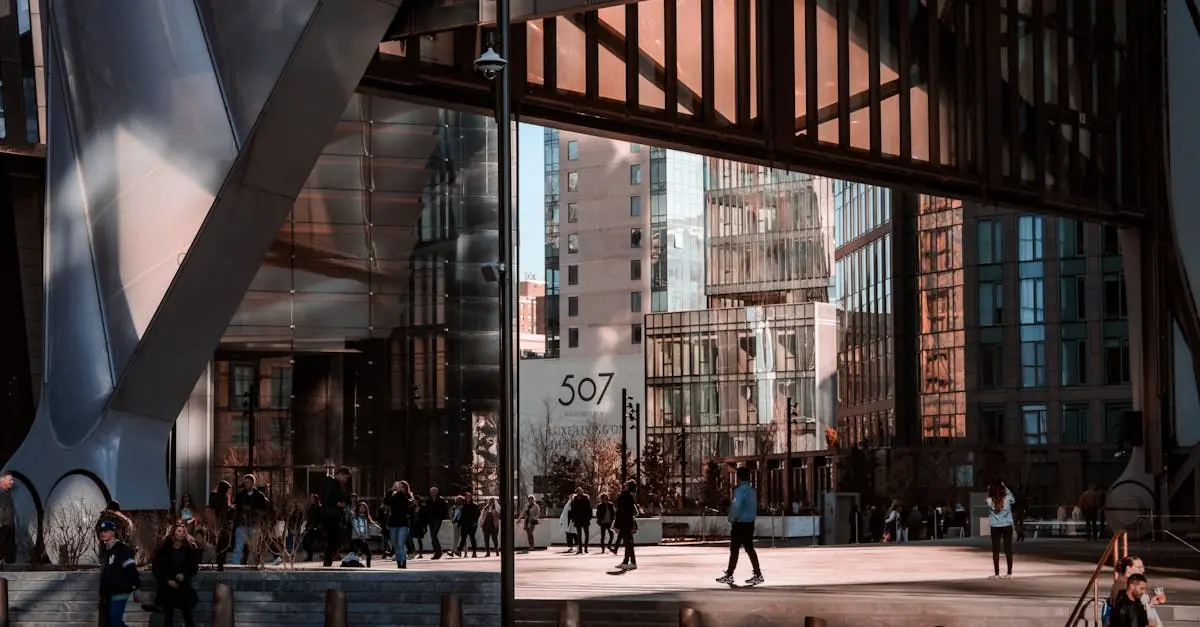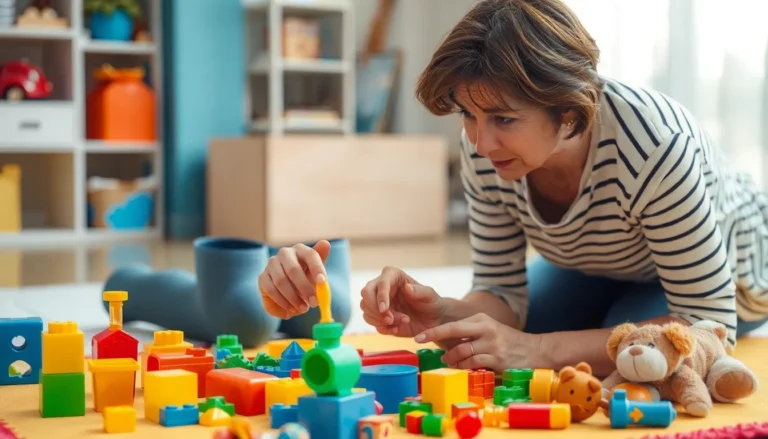Table of Contents
ToggleAcross the United States, state-level building trends are shaping the skylines and neighborhoods of tomorrow. From eco-friendly materials to innovative designs, every state is putting its unique twist on construction. If you think all buildings look the same, think again! Each region is embracing its quirks, whether it’s a high-rise in New York or a sustainable cabin in Oregon.
But why should anyone care about these trends? Well, understanding what’s happening in the building world can help homeowners, investors, and even curious onlookers make informed decisions. Plus, who wouldn’t want to impress their friends with the latest architectural jargon? So buckle up and get ready to explore how these trends are not just changing the way we build but also how we live.
Overview of State-Level Building Trends
Building trends across various states showcase a significant shift towards sustainability, innovation, and community-oriented designs. States such as California emphasize eco-friendly materials, promoting green building certifications like LEED. Colorado leads in using renewable energy in new constructions, enhancing energy efficiency and reducing carbon footprints.
Furthermore, urban areas in Texas are adopting mixed-use developments, combining residential, retail, and office spaces to foster vibrant communities. Florida is witnessing a rise in resilient design features, focusing on hurricane-resistant structures that enhance safety and longevity.
Architectural styles also vary significantly. The Northeast often embraces colonial and traditional designs, whereas the Pacific Northwest leans towards modern aesthetics with natural wood and large windows. Southern states frequently highlight elements that reflect local culture, such as porches and open floor plans catering to outdoor living.
Local building codes and regulations strongly influence these trends. States with stricter guidelines often promote higher standards of sustainability and safety. Innovative technologies, like smart home systems and advanced building materials, gain popularity in states with tech-driven economies.
Demographic shifts further dictate these trends. Growing populations in urban centers necessitate higher density housing solutions. Aging populations also push for accessible designs that cater to seniors and individuals with disabilities.
By understanding these dynamics, homeowners and investors can make informed decisions that align with both their needs and forward-thinking construction practices. Each trend highlights a unique approach to the evolving landscape of architecture across the United States.
Key Factors Influencing Building Trends
Building trends in the U.S. arise from various factors, significantly impacting the direction of construction practices across states.
Economic Considerations
Economic conditions heavily influence building trends. States experiencing growth in jobs and income see a surge in construction projects. Increased investment in infrastructure enhances the demand for residential and commercial spaces. Developers assess local market trends to determine pricing strategies, impacting the types of projects initiated. For example, in booming areas like Texas, a demand for affordable housing brings innovative solutions to the forefront. Additionally, interest rates play a crucial role; lower rates stimulate borrowing, prompting more projects to commence.
Regulatory Changes
Regulatory changes significantly shape building trends across states. New codes and standards often promote sustainability and energy efficiency. Many states enact stricter building codes to enhance safety and environmental impact. States like California lead with progressive regulations, pushing for higher efficiency in materials and construction practices. Compliance with these regulations not only reflects in building designs but also encourages innovative practices to meet requirements. As regulations evolve, they can dramatically alter the landscape of construction, dictating how and what gets built in various regions.
Regional Variations in Building Trends
Regional variations in building trends reveal distinct differences influenced by location, culture, and economic factors. Understanding these differences helps in recognizing the broader landscape of construction throughout the United States.
Urban vs. Rural Development
Urban development emphasizes high-density construction with multifamily housing, mixed-use developments, and commercial spaces. Cities often embrace innovative designs that maximize limited space, integrating green spaces within high-rises. In contrast, rural development focuses on single-family homes, expanding property sizes, and a strong connection to nature. Sustainability emerges as a priority in both settings, yet urban areas demonstrate a stronger push for eco-friendly infrastructure due to population density. Local governments promote smart growth strategies to enhance public transportation and community access.
High-Demand States
High-demand states such as Texas, California, and Florida showcase significant growth in construction projects. Texas attracts residents with affordable housing and economic opportunities, driving a surge in new developments, particularly in urban areas like Austin and Dallas. California leads in innovative building practices by emphasizing sustainability, with more projects utilizing solar energy and green materials. In Florida, hurricane-resistant structures dominate new construction to ensure safety while blending modern aesthetics. Each state’s unique demands reflect current trends, supporting community needs and long-term viability in residential choices.
Sustainable Building Practices
Sustainable building practices are transforming the construction landscape across the United States. States adopt initiatives focused on environmental stewardship and resource efficiency.
Green Building Initiatives
Various states implement green building initiatives aimed at minimizing environmental impact. For example, California leads with strict regulations promoting LEED certifications. Washington advocates for eco-friendly materials, ensuring builders adhere to sustainability principles. Local governments often provide incentives, encouraging developers to explore renewable energy solutions. New York City supports urban green spaces through initiatives like its Urban Forestry Program, enhancing biodiversity while improving residents’ quality of life. These initiatives highlight the growing commitment to sustainable construction practices nationwide.
Energy Efficiency Trends
Energy efficiency trends continue to shape building practices significantly. Many states incorporate advanced technologies to reduce energy consumption. California, for instance, mandates high energy standards for new constructions. Massachusetts promotes energy-efficient heating and cooling systems that optimize resources. Battery storage solutions also gain traction, allowing for better management of energy use. Local building codes frequently reflect these trends, driving contractors towards sustainable choices. States actively embracing these energy-efficient practices lead the way in creating environmentally friendly and cost-effective homes.
Challenges Facing State-Level Building Trends
Challenges impact the implementation of building trends at the state level, affecting the overall construction landscape across the United States. Two primary issues arise: supply chain issues and labor shortages.
Supply Chain Issues
Supply chain disruptions significantly influence construction projects. Delays in acquiring materials stem from global logistics challenges and increased demand for certain resources. Prices for key materials, such as lumber and steel, rise due to scarcity, impacting budget forecasts. States like California and Texas feel the effects more acutely, as high-resource demand leads to project slowdowns. Most builders adapt by sourcing locally or seeking alternative materials to mitigate costs. Navigating these challenges requires strategic planning to ensure timely project completion while maintaining quality standards.
Labor Shortages
Labor shortages create substantial obstacles for state-level building trends. Skilled labor gaps arise from an aging workforce and decreased interest in construction trades among younger generations. These shortages create bottlenecks in project timelines, as fewer workers result in slower construction rates. States like Florida and Colorado experience these labor constraints alongside rapid growth in housing demands. Employers respond by enhancing wages and offering training programs to attract new talent. Fostering partnerships with educational institutions also supports workforce development, preparing graduates for immediate employment in the construction industry.
Conclusion
State-level building trends are reshaping the landscape of construction across the United States. As sustainability and innovation take center stage, communities are witnessing a transformation in architectural practices that reflect local culture and environmental needs.
These trends not only enhance the aesthetic value of neighborhoods but also promote safety and efficiency. Homeowners and investors who stay informed about these developments can make decisions that align with sustainable practices and community-oriented designs.
With the ongoing challenges in supply chains and labor, the adaptability of builders will play a crucial role in meeting the demand for new constructions. Embracing these trends ensures a brighter future for both the construction industry and the communities it serves.








